Today there are various options for finishing the ceiling in the house. However, many owners still prefer painting or whitewashing. In turn, such options for finishing the ceiling on the balcony are often used. This is mainly due to the fact that the owners of the premises think that the conditions of this part of the dwelling do not allow the use of any other materials. However, it should be noted that the ceiling finishes familiar to many are considered somewhat outdated today. Today, the market offers a wide range of different materials, the characteristics of which allow them to be used in a variety of places. Next, consider the options for finishing the ceiling that are gaining popularity.
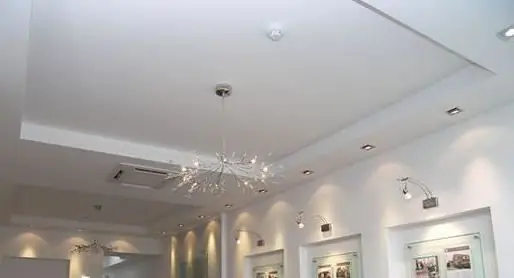
Classification
Today, the following ceiling finishes are gaining popularity:
- drywall,
- plastic tiles or panels,
- tree,
- decorative plaster,
- stretch fabrics.
The first material today is considered somewhat universal. For example, when considering options for finishing the ceiling in the bathroom, homeowners pay attentionon waterproof GVL sheets. This material has the necessary properties for its use in wet rooms. The bathroom is also often used and plastic. This material is easy to install, has a low weight, looks aesthetically pleasing. Considering options for finishing ceilings in an apartment, many consumers opt for stretch fabrics. This coating is practical, it can be used in different rooms, including those with high humidity.
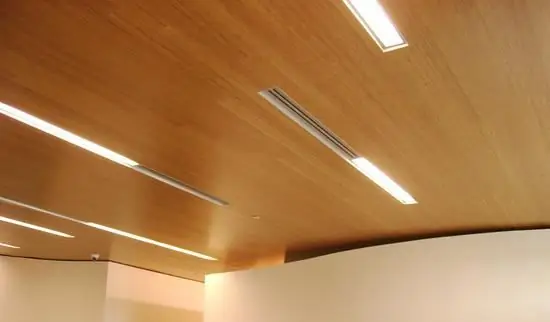
The most common modern material
Speaking about what options exist for finishing ceilings in an apartment, first of all, you should pay attention to GVL sheets. Using this material, you can create original and complex designs. As a result, the ceiling will become the main decoration of the interior of the house. GVL has soundproof properties. Therefore, considering options for finishing the bedroom ceiling, for example, this material is increasingly preferred. In addition, lamps can be built into the structures, which will add even more charm to the room. Also, LED strips can be used to create original lighting. For their installation, sub-ceiling and ceiling structures are created. The result can be quite impressive.
Stretch ceilings
It is believed that this is the easiest and fastest ceiling finish. The options here may vary. For example, you can choose a glossy or matte finish. However, this material is quite expensive. Often, considering optionsceiling decoration in the house, homeowners use a combination of different coatings. For example, combined designs of GVL and stretch fabric look spectacular. The latter may be a PVC film. It is pulled on a frame pre-installed around the perimeter. The effect of a single web is obtained by heating the film with special equipment. In addition to PVC, fabric is also used. In this case, heating is not required, and the result is very original.
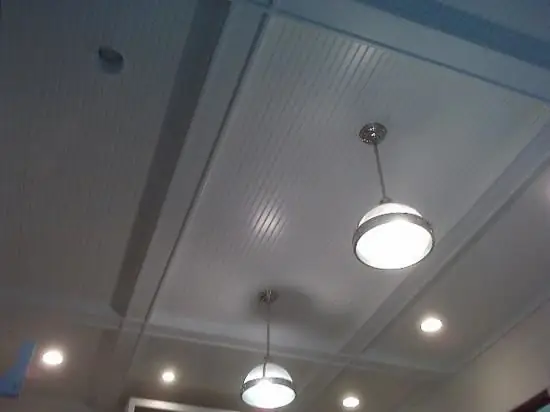
Here it must be said that the options for finishing the ceiling with fabric are a separate decoration sector. As a rule, in typical rooms it is possible to mount a seamless coating. But if the area is large enough, then several parts are soldered to each other. The advantages of a stretch ceiling include the speed of installation, the absence of the need to carry out complex preparatory work with the base, as well as a long period of operation. PVC fabric has high tensile strength. The disadvantages of the coating include susceptibility to damage from exposure to sharp objects. For example, in rooms with low ceilings, when bringing in large items, there is a high risk of damaging the canvas.
Coloring and whitewashing
Modern options for finishing the ceiling, of course, have a lot of advantages. However, many choose the traditional classics. Painting or whitewashing is the simplest ceiling finish. The options presented above either require large investments, or are not suitable for every interior. But the advantage of the traditionalstaining or whitewashing - in neutrality. Such options for finishing the ceiling in the country are often used. Country real estate for a seasonal stay does not require any sophisticated interior. Therefore, most often the ceilings in the country are painted or whitewashed. The surface looks clean and fresh. These ceiling finishes are often used in the kitchen and hallway. However, there are some nuances here. Let's take a look at some of them below.
Covering features
As for the process itself, the application of materials to the surface is not accompanied by any difficulties. Difficulties arise in the preparation of the foundation. Firstly, this work is rather "dirty". In this regard, at the very beginning of the preparatory stage, it is necessary to close all the furniture with polyethylene. The flooring and walls should also be protected. Next, you need to carefully align the ceiling. For this, plaster is used. The thickness of its layer will depend on the existing defects. If the differences relative to the walls are sharp enough, then re-applying the plaster will be required. Also, the surface must be clean. This means that it should not only be free of dirt and dust, but also various stains. If there are such areas on the ceiling, then it will have to be treated with special compounds. After the surface has been plastered, it must be primed. After the composition dries, putty is applied. If there was already whitewash or paint on the ceiling, then the coating is preliminarily removed. Only after that you can proceed to further work. As you can see, surface preparationquite tiresome.
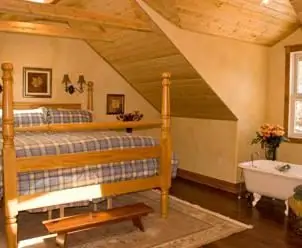
Advantages and disadvantages of staining or whitewashing
One of the main disadvantages of these finishes is their relative fragility. Over time, the coating turns yellow. If the plaster is applied in a thick layer, then cracks appear on it. Coatings, of course, also have advantages. For example, relatively low costs. However, if you think about the preparation process and the subsequent cleaning of the premises, then you should think about whether such savings are needed.
Simple decor
If painting or whitewashing is still chosen, then you can make the surface more original using polyurethane stucco. For example, often on the ceiling you can see the layout of the moldings. It will also add originality to painting, stained glass and other designs. Surface decoration can also be done using lighting. In addition, color is often added to white paint or whitewash. For example, greenish or blue ceilings visually make the room look higher, while pale orange, light lemon, cream or beige - "warmer".
Wallpapering
This option allows you to express your creativity. Pasting the ceiling with wallpaper is not as laborious as, for example, preparing for whitewashing or painting. You can hide surface defects, joints and seams between the plates with the help of dense foamed cloths. Some home craftsmen use glass wallpaper. This material can be repeatedly coated with paint. Among the disadvantages of wallpaper should be noted inconvenienceinstallation. It is more customary to glue them all the same on the walls. In addition, there is an opinion that this finish option is very outdated. But designers argue that the use of certain materials is a matter of taste. If you liked the wallpaper, then it is quite possible to stick them on the ceiling.
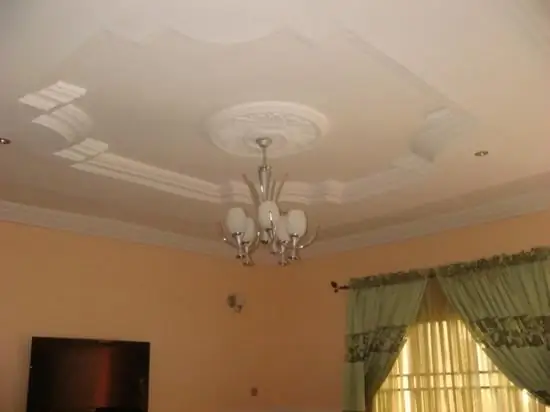
Polystyrene tiles
This is perhaps the easiest option for finishing the ceiling. This method does not require large investments. In addition, the installation of tiles on the ceiling can be done independently. Today, the market offers the widest range of this material. Polystyrene tiles are lightweight, water resistant, and practical. The material can be selected with a different pattern and shade. So-called seamless tiles are also produced. In this case, after installation, the joints of the elements are not visible. As a result, it seems that the coating is solid. There is an opinion that tiles are not very environmentally friendly for living quarters. However, according to experts, there is no more harm from it than from oil paint or wallpaper. The tile, in addition to its aesthetic appearance, has soundproofing properties and resistance to moisture. This material can be used in the kitchen or in the bathroom.
Suspended structures
Such ceilings consist of a frame and sheathing. The latter can be a variety of materials. However, it should be noted that suspended structures are not as popular as other types of finishes. This is due to their relatively high cost. The range of suspended structures is not so wide, but among the presented alternatives can be found quite original solutions. So, for example, the surface can be mirror, metal, wood. In addition, some designs have several levels. The undoubted advantage of suspended ceilings is their durability. They also do not require special care. The materials used in the production are not afraid of temperature changes. The biggest disadvantage of such structures is that they take at least 15 cm from the height of the room.
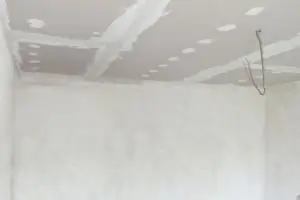
Beams
This solution is not suitable for every interior. The beams will look harmonious if the room is decorated in country or Provence style. At the same time, the elements can be artificially aged or deliberately rough. For a classic interior, painted and perfectly smooth lacquered beams are perfect. There are different options for laying elements. For example, they may overlap. The resulting niches are also decorated. Such a ceiling is called "caisson". It is incredibly beautiful, but also very expensive. This solution is suitable for an elite room. Coffered ceilings can be seen in antique interiors, for example. You can reduce the cost of the structure by replacing the wooden beams with polyurethane ones and choosing a simpler decor (wallpaper or paint).
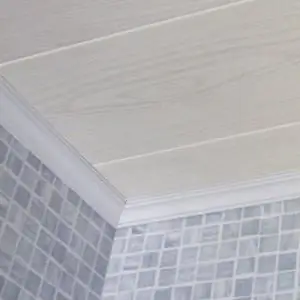
In conclusion
Of course, it is impossible to talk about all the existing finishes in one article. When choosing one or the otherexperts recommend paying attention to a number of points. In particular, on:
- Cost of coverage. This includes the price of material and labor (if required).
- Life, reliability and quality.
- Sustainability. For example, experts do not recommend using plastic when arranging the ceiling in a children's room or bedroom.
- The style of the room. When choosing one or another material, you should take into account the features of the interior. The finish should be in harmony with the existing décor.






